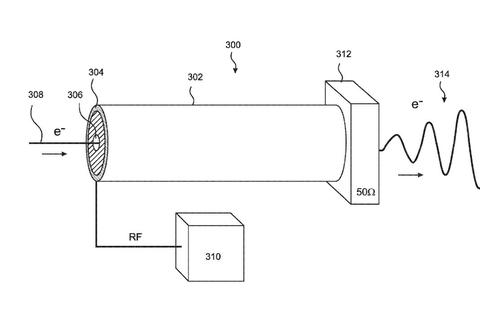Problem
This invention relates to apparatus and methods for generating and controlling low and medium energy pulsed electron beams at very high rates. It is based on a key component, the Transverse Deflecting Cavity ElectroMagnetic-Mechanical Pulser (TDC-EMMP), cited in another patent: US 20160293377 A1. This invention is a modified EMMP, called the Traveling Wave Transmission Stripline ElectroMagnetic-Mechanical Pulser (TWTS-EMMP), which allows one to chop an electron beam at a rate that is continuously tunable over a large frequency band. While the TDC-EMMP has the advantage of being applicable to a continuous range of beam energies, i.e. electron velocities, it is only able to operate at a few distinct resonant frequencies. In other words, the spatial oscillation rate, and therefore the electron pulsing rate, is limited to only a few values that correspond to resonant modes of the TDC cavity. In reality transmission electron microscopy (TEM) machines and many other applications to which the TDC-EMMP is applicable operate at a predetermined, fixed beam energy.
With reference to the figure below, the TWTS 300 in its most general form includes an outer conductive shell 302 filled with a dielectric 304, which is penetrated by a hole 306 through which a continuous beam of electrons 308 can be transmitted. Radio frequency energy, derived in embodiments from a frequency and amplitude tunable RF source 310, is introduced into the TWTS 300 at a proximal end thereof, and propagates through the TWTS as a traveling wave to a distal end thereof, which is terminated by a resistive load 312 that is matched to the impedance of the TWTS. The transverse electric field of the RF interacts with the electron beam 308 as it passes through the TWTS 300, so that the beam 308 emerges from the distal end of the TWTS 300 as a spatially modulated beam 314. In the embodiment of FIG. 3, the stripline 300 has an impedance of 50 ohms, and is terminated by a 50 ohm load 312.

Invention
An ElectroMagnetic-Mechanical Pulser (“EMMP”) generates electron pulses at a continuously tunable rate between 100 MHz and 20-50 GHz, with energies up to 0.5 MeV, duty cycles up to 20%, and pulse widths between 100 fs and 10 ps. A dielectric-filled Traveling Wave Transmission Stripline (“TWTS”) that is terminated by an impedance-matching load such as a 50 ohms load imposes a transverse modulation on a continuous electron beam. The dielectric is configured such that the phase velocity of RF propagated through the TWTS matches a desired electron energy, which can be between 100 and 500 keV, thereby transferring electromagnetic energy to the electrons. The beam is then chopped into pulses by an adjustable aperture. Pulse dispersion arising from the modulation is minimized by a suppressing section that includes a mirror demodulating TWTS, so that the spatial and temporal coherence of the pulses is substantially identical to the input beam.
Features
Many of the important applications to which the Transverse Deflecting Cavity Traveling Wave Transmission Stripline r (TDC-EMMP) is applicable would benefit significantly from the EMMP having a highly broadband, continuously variable pulsing rate, rather than a continuously variable of beam energies. The Traveling Wave Transmission Stripline ElectroMagnetic-Mechanical Pulser (TWTS-EMMP) allows this tunability.

